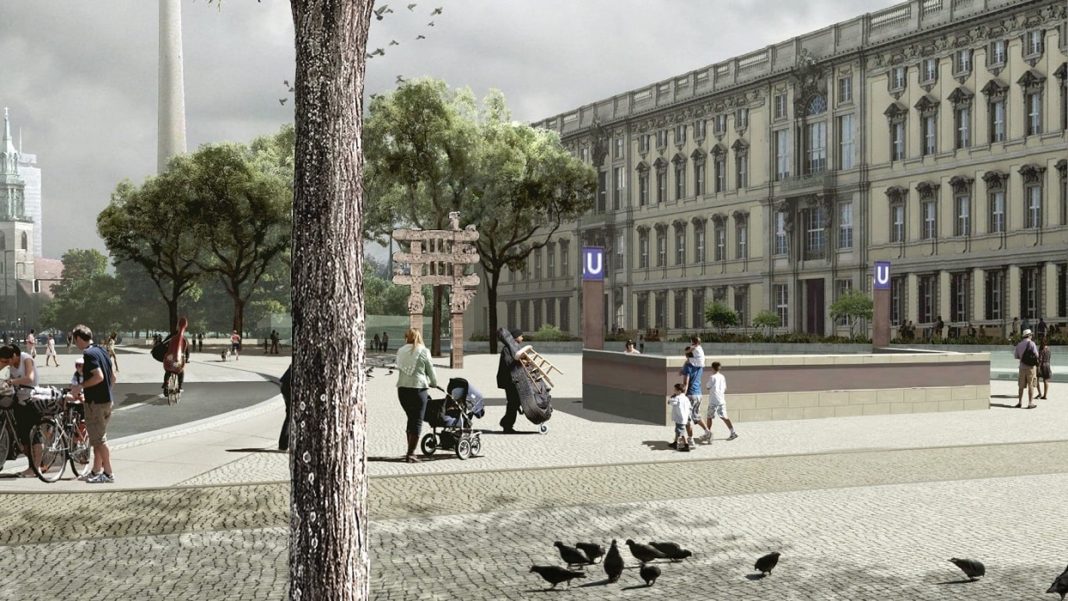On the Lustgarten side of the Humboldt Forum, the replica of an ancient Indian gate will enrich the outdoor space: the famous East Gate of Sanchi. As part of one of the oldest and most important preserved Buddhist sanctuaries, the gateway in India is a UNESCO World Heritage Site. A plaster cast of the original gate was on display in Berlin from 1886 in what was then the Royal Museum of Ethnology; another copy made of cast stone has been on display in Berlin-Dahlem since 1970. The completion of the replica made of sandstone for the Humboldt Forum, in which stone sculptors from India are also involved, is planned for the end of the year.
Image above: Rendering aus der Vorplanung © Stiftung Humboldt Forum im Berliner Schloss
In front of Portal 5 of the Humboldt Forum in the Berlin Palace, work is currently underway to erect a replica of the magnificent Sanchi Gate, which in future will point to the famous collections of the Ethnological Museum and the Museum of Asian Art in the Humboldt Forum in a highly visible location on Schlossplatz opposite the Berlin Cathedral. The new moulding is a replica, milled from sandstone for the first time, of Sanchi’s East Gate, which is almost 10 metres high and about 6 metres wide. Detailed scenes decorate the picture surfaces of the three crossbeams and the two pillars. Most of them are episodes from the life of the Buddha. Buddhist symbols, depictions of erotic-looking lucky genii, but also beautiful animal depictions of elephants, lions or peacocks frame the pictorial narratives in festive abundance. Nevertheless, you will look in vain for a figurative Buddha image here. For the Buddha was represented in the picture at that time by symbols: e.g. by a throne under a tree, by footprints or the like.
The original gateway structure in the Indian state of Madhya Pradesh still serves as one of four entrances to the ‘Great Stupa’, one of three great stupas at the site of Sanchi, one of the oldest surviving Buddhist shrines listed as a UNESCO World Heritage Site since 1989. A stupa is a hemispherical, built ‘mound’, inside of which relics and reliquaries of Buddhist saints, considered beneficial, are kept. The ‘great stupa’ of Sanchi dates back to the time of King Ashoka in its oldest parts. Later it was almost entirely rebuilt and enlarged. In the 1st century AD, the four stone entrance gates (toranas) with detailed reliefs followed. They are aligned according to the four cardinal points, which underlines the universal character of the stupa and the Buddhist teachings. Each of the arches, which are over eight metres high, consists of two pillars, each of which is connected at the top with three crossbeams. The overall construction is probably derived from – not preserved – wooden models.
However, the new replica of the ancient East Gate of Sanchi will not be the first time that Buddhist artistry has been admired in Berlin. A plaster cast of the original gate purchased from London was already on display in the atrium of the then Royal Museum of Ethnology from 1886. And in 1970, on the basis of the plaster cast that had fortunately survived, a new cast was made of cast stone and placed in the then-opening Museum of Indian Art in the Garden of the Museums in Berlin-Dahlem, where it can still be seen today.
The new copy – made of solid Main sandstone from Röttbach in with a slightly reddish hue now even more similar to the original – was also made possible thanks to the old plaster moulds still preserved in the depot of the National Museums in Berlin. These were first scanned in a 3D scan using modern photographic techniques and then transferred with the help of CAD technology and modern 5-axis stone milling machines. The actual sculptural work, on the other hand, is still done by hand. The work was carried out at the Hermann Graser natural stone factory in Bamberg with the support of Indian craftsmen. An individual style of craftsmanship – analogous to the original gate in India – was expressly desired. Passers-by and visitors will be able to form a first impression of the artful, filigree work at the end of the year, when the work will be completed.
Accompanying the reconstructed gate will be a bronze model of the “great stupa” of Sanchi, which will explain the reconstruction, make the entire complex understandable and also serve as a tactile model for visually impaired people.
Hartmut Dorgerloh, General Director: “I am very excited about the replica of the East Gate of the Sanctuary of Sanchi in front of the Humboldt Forum. As an exciting counterpoint to the baroque façades, what visitors can look forward to inside the building will now also be visible in front of the portals of the Humboldt Forum: The diversity of the world in the centre of Berlin.”
Hans-Dieter Hegner, Chief Technology Officer of the Humboldt Forum Foundation in Berlin’s lap: “The planning and construction of the Sanchi Gate is an exemplary result of good cooperation between scientists, restorers, architects and engineers as well as stone sculptors in a unique project. From an urban planning perspective, too, the Sanchi Gate establishes new connections between the street Unter den Linden with the Brandenburg Gate on one side and the Humboldt Forum and Museum Island on the other. I would like to thank all those involved in the project as well as supporters from India for their benevolent support.
S.E. Harish Parvathaneni, Ambassador of the Republic of India: “The initiative of the Humboldt Forum to place the replica of the Sanchi Gate in the heart of Berlin deserves high recognition as the gate is a unique architectural feature of the Buddhist monuments at Sanchi, a UNESCO World Heritage Site of outstanding universal value dating back to the 2nd century BC. It embodies Buddha’s message of peace, compassion and love for all living beings. Buddha and his teachings are universal and symbolise the Indian civilisational ethos of peaceful coexistence between humans and nature as well as different faiths and cultures. The Humboldt Forum has chosen to exhibit the replica in a diverse and multicultural city with an eventful history and rich heritage. The Embassy of the Republic of India in Berlin appreciates the efforts of all those who have worked towards the installation of the replica of the Sanchi Gate: It represents the close relationship between India and Germany and the long-standing, strong ties between the people of our countries.”
Lars-Christian Koch, Director of the Ethnological Museum and the Museum of Asian Art of the National Museums in Berlin: “The fact that the East Gate of the ‘Great Stupa’ of Sanchi will now also be a new replica in front of the Humboldt Forum, pointing to the collections of the Ethnological Museum and the Museum of Asian Art now located here, is a very special pleasure for me. The gate was already a landmark for many visitors in Dahlem and it will be even more so in the centre of Berlin.”
Hermann Graser, Bamberger Natursteinwerk Hermann Graser: “We are very pleased that we were able to make our contribution to this wonderful project. The replica of the Sanchi Gate was very special because of the Indian filigree sculpture work and the exchange with our Indian guests. A project truly across cultures and national boundaries.”
The polyphony that characterises the programme of the Humboldt Forum is also reflected in the interaction between the actors: The Humboldt Forum brings together the Humboldt Forum Foundation in the Berlin Palace, the Prussian Cultural Heritage Foundation with the collections of the Ethnological Museum and the Museum of Asian Art of the National Museums in Berlin, the Humboldt-Universität zu Berlin with the Humboldt Laboratory and the Stadtmuseum Berlin with the Berlin Exhibition.
WHERE?
Humboldt Forum
Schloßplatz 1
10178 Berlin-Mitte






